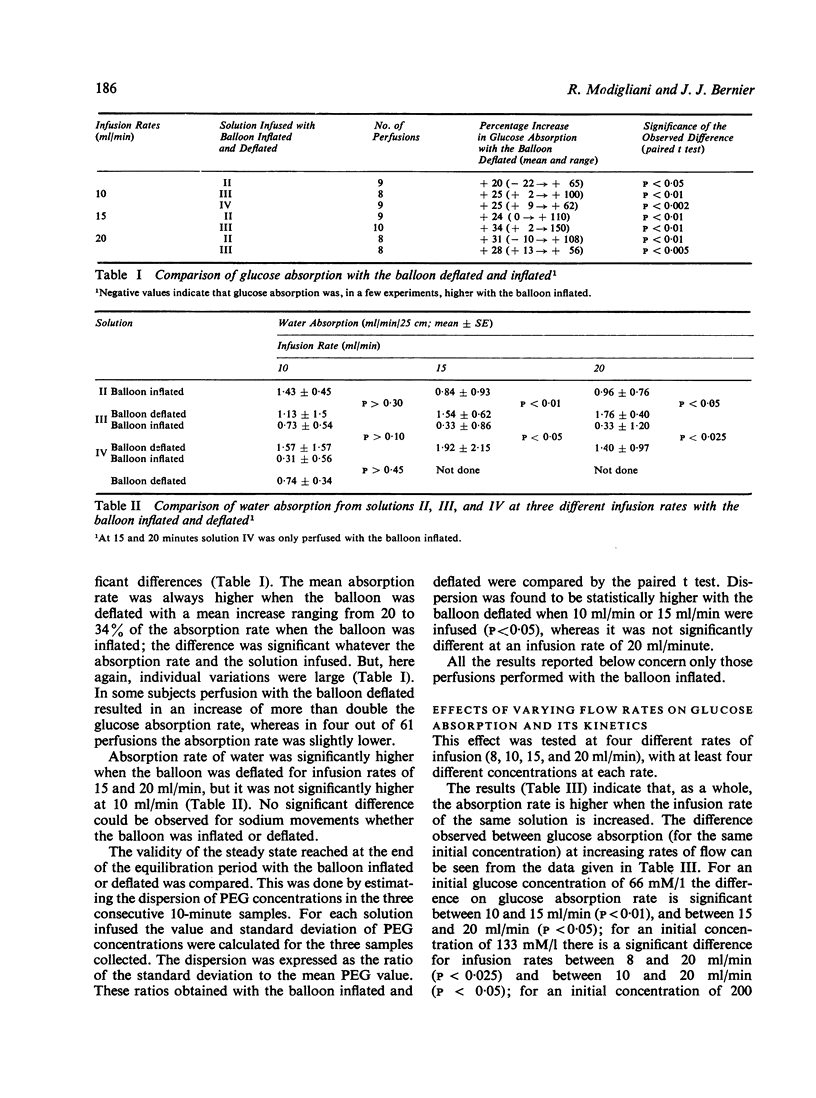Abstract
A perfusion technique with a proximal occluding balloon has been used to study the absorption of glucose, sodium, and water from the human jejunum at different rates of flow. The absorption of glucose and water was significantly higher with the balloon deflated than inflated, probably because of reflux of infused solution above the point of infusion. Above the inflated balloon 0 to 4·2 ml/min of endogenous secretions could be recovered. Increasing flow rates increase the glucose absorption rate; a single relationship could be found between the glucose load and glucose absorption rate, and single values for the maximum velocity and for the half saturating load were calculated whatever the infusing rate and the initial glucose concentration. The stimulating effect of glucose on water and sodium movement increases gradually when the initial sugar concentration varies from 14 to 133 mM/1. Above this concentration a drop in water and sodium movement is observed, although the initial sodium concentration is kept constant. High flow rates result in a decrease of water absorption and an increase in sodium and potassium secretion rates.
Full text
PDF









Selected References
These references are in PubMed. This may not be the complete list of references from this article.
- Adibi S. A. The influence of molecular structure of neutral amino acids on their absorption kinetics in the jejunum and ileum of human intestine in vivo. Gastroenterology. 1969 May;56(5):903–913. [PubMed] [Google Scholar]
- CODE C. F., HIGGINS J. A., ORVIS A. L. The influence of motility on the rate of absorption of sodium and water from the small intestine of healthy persons. Gastroenterology. 1956 Dec;31(6):708-15; discussion, 715-6. [PubMed] [Google Scholar]
- CUMMINS A. J., ALMY T. P. Studies on the relationship between motility and absorption in the human small intestine. Gastroenterology. 1953 Feb;23(2):179–198. [PubMed] [Google Scholar]
- FORDTRAN J. S., SOERGEL K. H., INGELFINGER F. J. Intestinal absorption of D-xylose in man. N Engl J Med. 1962 Aug 9;267:274–279. doi: 10.1056/NEJM196208092670602. [DOI] [PubMed] [Google Scholar]
- Fordtran J. S., Rector F. C., Jr, Carter N. W. The mechanisms of sodium absorption in the human small intestine. J Clin Invest. 1968 Apr;47(4):884–900. doi: 10.1172/JCI105781. [DOI] [PMC free article] [PubMed] [Google Scholar]
- Fordtran J. S. Segmental perfusion techniques. Gastroenterology. 1969 May;56(5):987–989. [PubMed] [Google Scholar]
- GROISSER V. W., FARRAR J. T. Absorption of radioactive sodium from the intestinal tract of man. I. Effect of intestinal motility. II. Effect of an organomercurial. J Clin Invest. 1960 Nov;39:1607–1618. doi: 10.1172/JCI104183. [DOI] [PMC free article] [PubMed] [Google Scholar]
- Gray G. M., Ingelfinger F. J. Intestinal absorption of sucrose in man: interrelation of hydrolysis and monosaccharide product absorption. J Clin Invest. 1966 Mar;45(3):388–398. doi: 10.1172/JCI105354. [DOI] [PMC free article] [PubMed] [Google Scholar]
- Gray G. M., Santiago N. A. Disaccharide absorption in normal and diseased human intestine. Gastroenterology. 1966 Oct;51(4):489–498. [PubMed] [Google Scholar]
- HOLDSWORTH C. D., DAWSON A. M. THE ABSORPTION OF MONOSACCHARIDES IN MAN. Clin Sci. 1964 Dec;27:371–379. [PubMed] [Google Scholar]
- McMichael H. B., Webb J., Dawson A. M. The absorption of maltose and lactose in man. Clin Sci. 1967 Aug;33(1):135–145. [PubMed] [Google Scholar]
- NELSON R. A., BEARGIE R. J. RELATIONSHIP BETWEEN SODIUM AND GLUCOSE TRANSPORT IN CANINE JEJUNUM. Am J Physiol. 1965 Feb;208:375–379. doi: 10.1152/ajplegacy.1965.208.2.375. [DOI] [PubMed] [Google Scholar]
- Phillips S. F., Summerskill W. H. Occlusion of the jejunum for intestinal perfusion in man. Mayo Clin Proc. 1966 Apr;41(4):224–231. [PubMed] [Google Scholar]
- Phillips S. F., Summerskill W. H. Water and electrolyte transport during maintenance of isotonicity in human jejunum and ileum. J Lab Clin Med. 1967 Oct;70(4):686–698. [PubMed] [Google Scholar]
- SCHULTZ S. G., ZALUSKY R. ION TRANSPORT IN ISOLATED RABBIT ILEUM. II. THE INTERACTION BETWEEN ACTIVE SODIUM AND ACTIVE SUGAR TRANSPORT. J Gen Physiol. 1964 Jul;47:1043–1059. doi: 10.1085/jgp.47.6.1043. [DOI] [PMC free article] [PubMed] [Google Scholar]
- Sladen G. E., Dawson A. M. An evaluation of perfusion techniques in the study of water and electrolyte absorption in man: the problem of endogenous secretions. Gut. 1968 Oct;9(5):530–535. doi: 10.1136/gut.9.5.530. [DOI] [PMC free article] [PubMed] [Google Scholar]
- Sladen G. E., Dawson A. M. Effects of flow rate on the absorption of glucose in a steady state perfusion system in man. Clin Sci. 1969 Feb;36(1):133–145. [PubMed] [Google Scholar]
- Sladen G. E., Dawson A. M. Interrelationships between the absorptions of glucose, sodium and water by the normal human jejunum. Clin Sci. 1969 Feb;36(1):119–132. [PubMed] [Google Scholar]
- Soergel K. H. An evaluation of perfusion techniques in the study of water and electrolyte absorption in man: the problem of endogenous secretions. Gut. 1969 Jul;10(7):601–601. doi: 10.1136/gut.10.7.601. [DOI] [PMC free article] [PubMed] [Google Scholar]
- Summers R. W., Schedl H. P. Effects of tonicity and glucose on intestinal sodium and water absorption in the rat. Scand J Gastroenterol. 1968;3(4):376–382. doi: 10.3109/00365526809180132. [DOI] [PubMed] [Google Scholar]
- Whalen G. E., Harris J. A., Geenen J. E., Soergel K. H. Sodium and water absorption from the human small intestine. The accuracy of the perfusion method. Gastroenterology. 1966 Dec;51(6):975–984. [PubMed] [Google Scholar]


